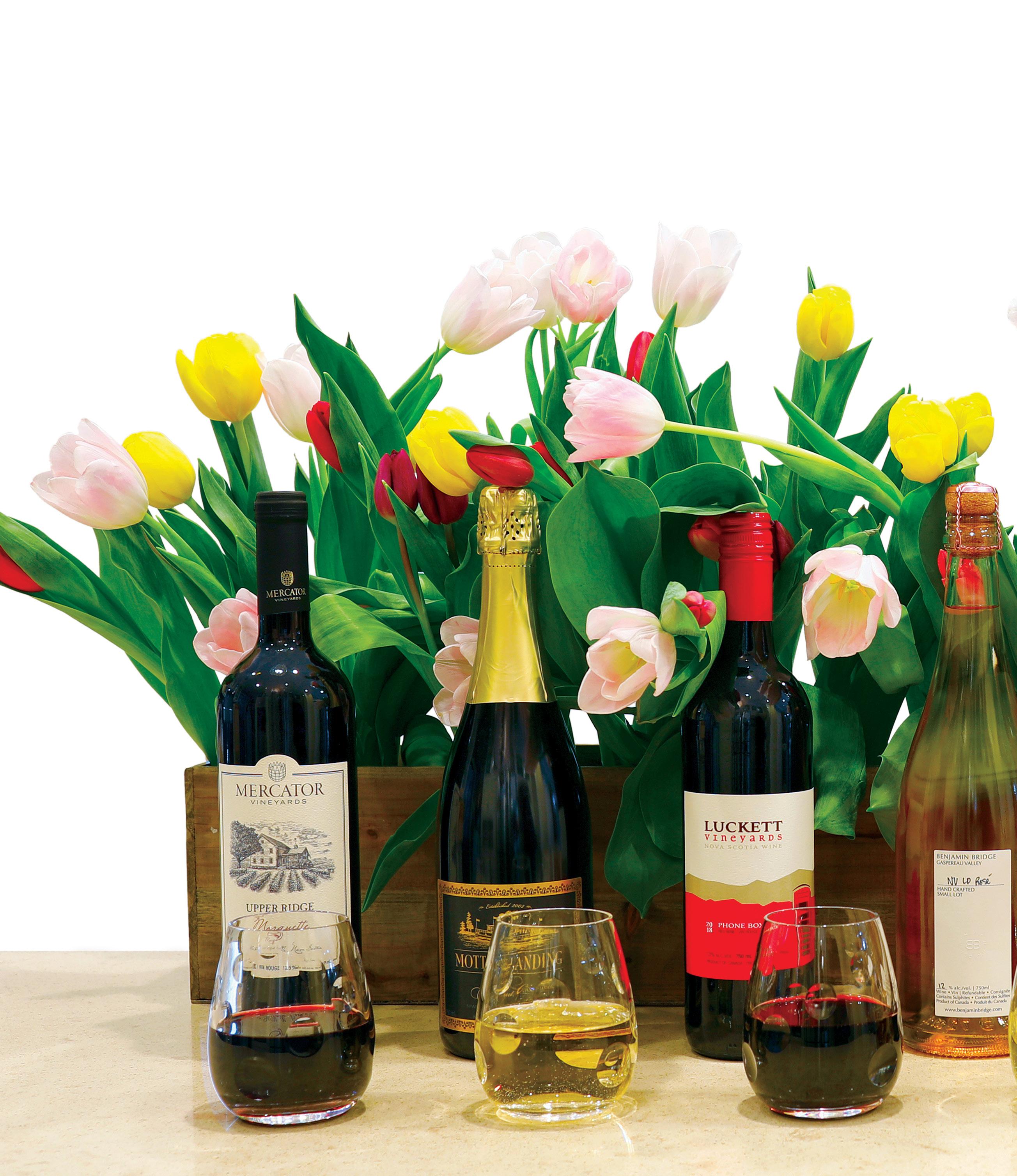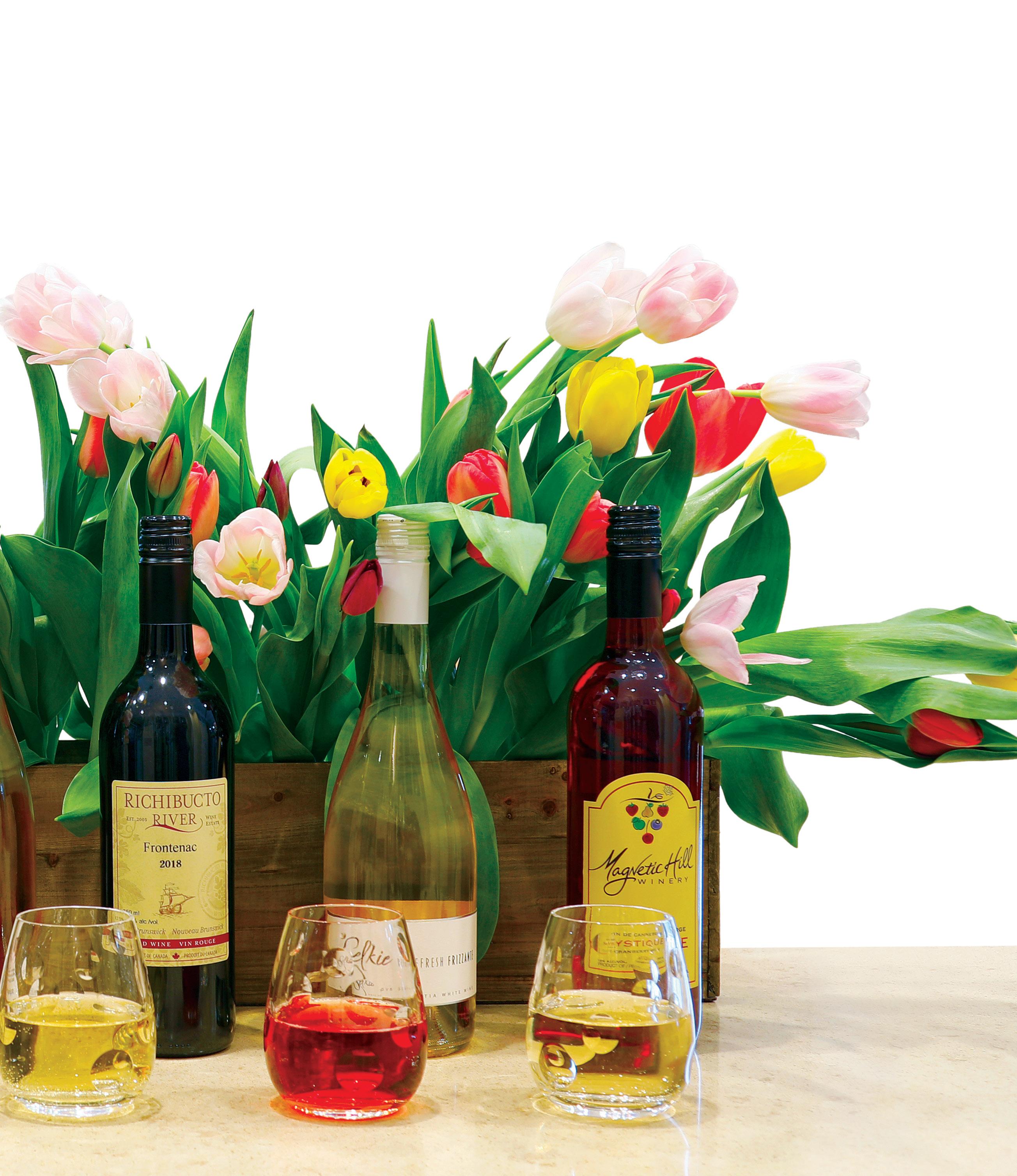
7 minute read
Libations: Open your senses to East Coast wine
Open your senses to East Coast wine
Atlantic Canadian vintners have moved from frontier to frontline, blending traditional methods and innovations
BY SARA ERICSSON
Wine is not just about savouring tastes for Moira Peters. The notes she looks for in her glass are not just flavour profiles or what’s on the nose, but also people and place–the toil and talent that came together to create what’s inside that glass. Each wine tells a story and Peters says the story told by East Coast wines is one of winemakers pairing a cold climate with novel ideas on how to capture landscape in a bottle.
“I tell people who are new to East Coast wines to use their senses, not biases, when approaching wine … and to come to table with open mind and open palate [to] see what the wine is telling us,” says Peters. “Our wines continue to tell a story of excitement and struggle, of potential and success,” she says. It’s a story she and fellow sommelier Craig Pinhey captured within a story of their own, A Wine Lover’s Guide to Atlantic Canada, and one that’s evolved since the book’s 2016 publishing.

PHOTO: CONTRIBUTED
Pinhey says New Brunswick is following a similar path to the Annapolis Valley and is on the verge of its own boom and regional renown, while Newfoundland, at one time among the world’s largest blueberry wine producers, has been producing exciting wines from its unique berries like cloudberries, partridge berries, and crow berries. Prince Edward Island, which Pinhey says has a small but mighty wine industry, continues producing a strong offering of white wines that captures a lot of tourist attention.
Peters says the East Coast region’s most renowned wines—whites, chief among them the Tidal Bay, and sparkling whites—are both part of the regional story of excitement and struggle, of breaking down barriers while convincing wine consumers with traditional tastes to try something new.
“Our winemakers are being really smart about the grapes they grow and figuring out what kind of style of winemaking uses them best,” says Peters. “I’d be proud to pour a Tidal Bay or traditional method sparkling for any wine critic that came around.”
Peters says the region’s traditional method sparkling whites are making international waves and are her choice for wine connoisseurs, but she is equally as excited by the region’s aromatic cabernet franc wines, with aromas created as a direct result of this cool-climate region. Open the bottle, pour it in the glass, swirl, then sniff. Peters says this will reveal an aroma bomb unlike any other, one that’s sure to please wine experts and newcomers alike.
“I applaud the wineries’ embracing of our grapes not being able to ripen, which produces really great, light, fruity red wines that are pleasant, interesting and easy to drink. You won’t find aromas like these anywhere else,” she says.

VIRTUAL VINO
The COVID-19 pandemic has moved in-person events to virtual platforms, including wine tastings. New Brunswick wine writer, sommelier and tastings host Craig Pinhey has hosted virtual wine tastings, including his family’s annual Pinot Party. Pinhey says a virtual tasting may be different than in person but is still a great way to gather and enjoy wine together.
“I hosted our party through my Zoom account and gave each person a turn to do a blind wine tasting where they had to guess which kind of pinot it was. It was weird, but fun,” he laughs.
Bottles up
Throw a party with taste with these pro tips on how to host your own wine tasting
BY SARA ERICSSON
You don’t need to be a wine expert to host your own tasting, but tips from one could bring your do-it-yourself tasting party to the next level.
Nova Scotia wine writer, sommelier and Unwined tasting party host Moira Peters says that $200 will get you a great selection of wines – she recommends eight bottles, among them white wine, red wine, rosé and sparkling – for an eight-to-10-person tasting. But Peters says hosting a tasting is about more than just the wine. There are subtleties to consider, such as lighting.
“It’s so important to have decent light and that really surprises people. It’s really nice to appreciate how the glass of wine looks, especially with rosés, which sparkle, or sparklings. It’s nice to take a moment and enjoy the visual beauty of wine,” she says.
To capture that visual beauty, Peters says tasters should swirl their glasses. This means glasses should have a large bowl, with enough room for swirling without spilling. When it comes to food, Peters says hosts can plan some pairings or even a snack break in the middle of the tasting as a palate cleanser–crostinis or rice crackers–but should never overwhelm the tasting with too much food.
There is one non-negotiable element that all tasting parties must have, according to Peters: a pen and some paper, so guests can note down their tasting impressions. If people are wondering what to write down, Peters says to narrow it down to two factors: whether you liked the wine and whether it was good value for money, since good wine can be found at any price.
“Good wine doesn’t have to be expensive. I often bring a range of wines, including a boxed wine, a Nova Scotia wine and a sparkling, along with a good selection of whites, rosé and reds, including one pricey bottle. When people note down which is their favourite, you might be shocked–people are often surprised at what they ended up liking,” she says.
PHOTO: STEVE SMITH/VISIONFIRE

Motts Landing Vineyard and Winery a humble leader in soon-to-boom N.B. wine industry
BY SARA ERICSSON
NEW BRUNSWICK IS BOOMING
Saint John, N.B. sommelier and wine writer Craig Pinhey says white wines and traditional method sparklings are the province’s forte. He says while previously little acclaim existed for these wines internationally, they are now winning over wine critics around the world.
“New Brunswick has found the grapes that will allow them to move forward and make good wines. Now all it needs is the support to get them planted,” he says.

Other wines including a barrel-aged red are among those available at the winery.
When David Craw purchased land in the Saint John River Valley, he bought it for the same reason a person buys their dream house– because it was beautiful. He may not have known it would soon be among the wineries leading New Brunswick’s burgeoning wine industry, but that makes this story even better.
David and his life and winemaker partner Sonia Craw were both new to wine when Motts Landing Vineyard and Winery first started: Sonia worked in agriculture as an environment technologist, David flew for an airline.
“I couldn’t even grow a radish when we started,” he laughs.
Stumbling across the site was a happy accident. David later learned the property sits on roughly the same latitude as France’s Bordeaux region and is part of the Saint John River Valley microclimate. With this information, Sonia began studying winemaking in New Zealand and later worked in the Annapolis Valley wine and vine industry.
She returned to New Brunswick and the pair began experimenting, growing the winery from a beautiful patch of waterside land into an intimate vineyard set up that seems beyond its years. Sonia’s wines, including her traditional method Brut Classic sparkling white wine, are making waves with wine enthusiasts.
“After many years of experimental grape growing and wine making, we know what grapes will finish and what wine styles to produce. Our sparkling is world class. It’s been an interesting journey with a lot of learning curves along the way,” says Sonia.
Rave reviews are pouring in, including from Nova Scotia wine writer and sommelier Moira Peters, who calls Sonia’s Brut Classic “hands down the best value traditional method sparkling wine in the entire east coast region.” Even with such rave reviews, David and Sonia remain humble, keeping on with their wine production and vine experiments. They are proud of what they have produced so far and of where their hard work has taken them.
For David, the ultimate dream is to see the old farms lining the shores of their Washademoak Lake repurposed into vineyards and together creating a wine region that will help propel New Brunswick to the frontlines of Canada’s wine industry.
“I think what we have done is we’ve proved it’s possible,” he says. o




